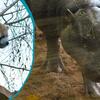For last week's International Gibbon Day, leading conservation charity Twycross Zoo announced the new arrival of a pileated gibbon.
The gibbon infant was recently born at the zoo and has been carefully looked over by the zoo’s team of expert keepers & veterinarians. To celebrate the new arrival, the Midlands-based zoo has released an exclusive set of photos.
The female infant, who is yet to be named, was born to mother Valentina, who is 25-years-old and 43-year-old father Helmut.
Both Helmut and Valentina are very important individuals within the EAZA Ex-situ Programme (EEP) for pileated gibbons, due to their genetics. The programme, which runs across zoos in Europe, consists of just 56 individuals and is coordinated by Twycross Zoo. It aims to conserve a healthy population of these animals in zoos, so this latest birth is a real success for the ongoing protection of the species.
Twycross Zoo’s pileated gibbons live along three other gibbon species in their world-class Gibbon Forest habitat. The new arrival still spends all her time on mum, but is becoming increasingly aware of her surroundings. The infant will remain with her parents for several more years as she grows and develops.
Lynsey Bugg, Curator at Twycross Zoo, is the EAZA Ex-situ Programme (EEP) coordinator for the pileated gibbon. She says:
“We’re delighted to announce the birth of a pileated gibbon at Twycross Zoo. It’s always a special moment when we welcome any new arrival and this birth is incredibly important as part of the pileated gibbon EEP, which is dedicated to protecting future populations of the species, who continue to face severe threats in the wild.
“As a conservation charity, our overarching aim is to help save the species with whom we share our planet through conservation action. We recently unveiled our ambitious new Conservation Strategy, and supporting healthy ex-situ populations of species is one of our six core conservation goals that will help maximise our impact in the fight against extinction.”
The pileated gibbon species is listed as “Endangered” by the International Union for Conservation of Nature (IUCN) and is native to Cambodia, Thailand and Laos. Pileated gibbons are sexually dimorphic (different) - males are black with white hands, feet and face crest, while females are white-grey with a black cap and chest.
The species faces a number of threats in the wild, most critically deforestation and habitat loss, as wild forest is converted into farmland or used for human developments. Pileated gibbons are also threatened by hunting for meat and the pet trade.
Lynsey Bugg continues:
“This month, the IUCN Species Survival Commission published a momentous Position Statement recognising the vital work of zoos, just like Twycross, as being critical to their mission of conserving wildlife. Today, more than ever, we must all work together to tackle some of the biggest challenges facing our planet, to ensure the preservation of species both here in the UK and internationally.
“But we can’t continue our conservation mission without the support of our visitors. A visit to Twycross Zoo is so much more than a day out, as every single visit allows us to continue our vital conservation work."
Related Members
-
News
 Belfast Zoo helps to bring Christmas joy to Children’s Hospital 19th December, 2025Belfast Zoo joined the Lord Mayor of Belfast, Councillor Tracy Kelly, on Monday (15th December) to help bring festive cheer to the Royal Belfast Hospital…
Belfast Zoo helps to bring Christmas joy to Children’s Hospital 19th December, 2025Belfast Zoo joined the Lord Mayor of Belfast, Councillor Tracy Kelly, on Monday (15th December) to help bring festive cheer to the Royal Belfast Hospital… -
News
 Colchester Zoological Society welcomes new arrivals 19th December, 2025This December, Colchester Zoological Society (CZS) welcomed some exciting new arrivals! A young male pygmy hippo, Mikolas, from Zoo Dvur Kralove…
Colchester Zoological Society welcomes new arrivals 19th December, 2025This December, Colchester Zoological Society (CZS) welcomed some exciting new arrivals! A young male pygmy hippo, Mikolas, from Zoo Dvur Kralove… -
News
.png?w=100&h=100&zc=1&f=jpeg&hash=8d175f93cde920c5ba23c8ea7f92e55a) Blog: Understanding the human side of zoos 16th December, 2025Why are zoo researchers increasingly looking to social science? Dr Nieky van Veggel explains the significance of understanding the human dimension…
Blog: Understanding the human side of zoos 16th December, 2025Why are zoo researchers increasingly looking to social science? Dr Nieky van Veggel explains the significance of understanding the human dimension…


